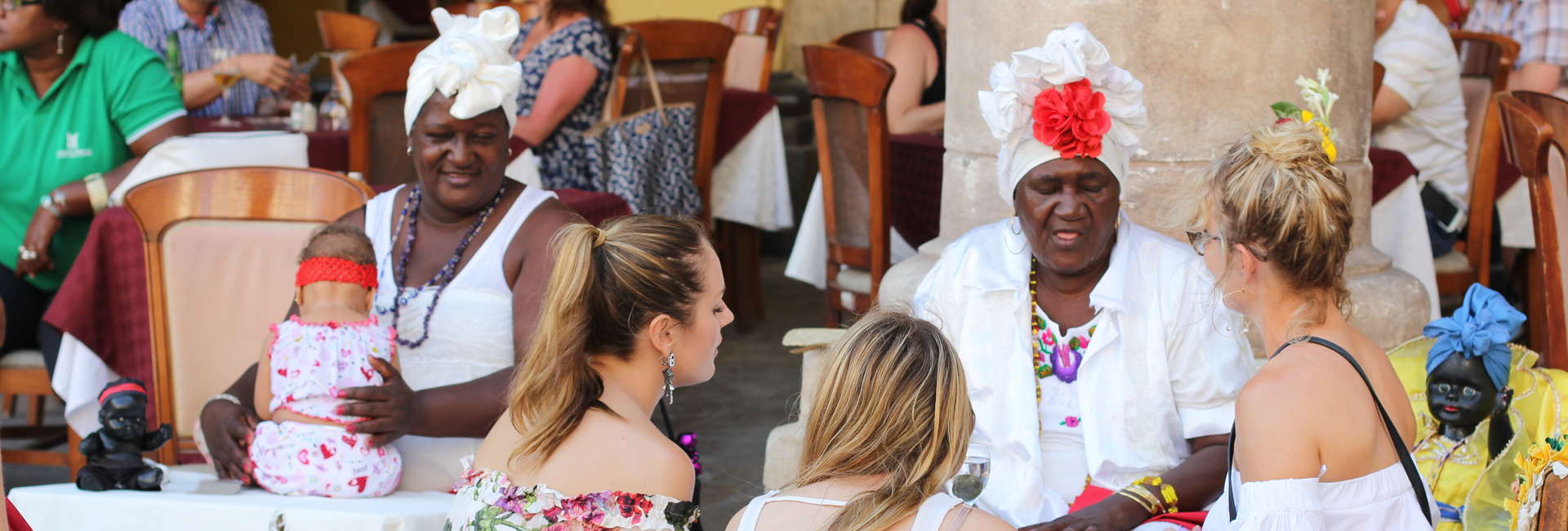

UM religion experts discuss how Afro-Cuban religions have survived and evolved from its early roots in the slave trade to the Cuban diaspora.
On an island where religion has been oppressed for the past 60 years, practicing your religious faith now in Cuba seems to be a little easier. Credit it to growing technology and American tourists.
When Fidel Castro and his communist government took control in 1959 he declared religion was no longer allowed, driving religious practices underground. That move helped blur the lines between faiths.

“You have folks that will go to Catholic mass and practice Santeria at home or other Afro-Cuban religions,” says Michelle Maldonado, professor of religious studies and the assistant provost for undergraduate education at the University of Miami College of Arts and Sciences.
In addition to Catholicism and Santeria, other religions have also grown in prominence and popularity during the past several years, such as Protestantism and Espiritismo, the belief in communicating with the dead. Although Catholicism has been seen on the island during Pope Francis’ visits and the Vatican’s role in helping to normalize relations between Cuba and the United States, it hasn’t diminished Afro-Cuban religions.
About the Photo
Santeria women give tourists tarot card readings in Old Havana’s Plaza de la Catedral. Photo credit: Jessica M. Castillo
Join the Conversation:
Follow on
Twitter:
UM College of Arts and Sciences, @UMCAS
University of
Miami, @unUMCASivmiami
UM News,
@univmiaminews
“With the rise of Protestant churches on the island, there is a sharp rejection of Afro-Cuban culture that you also see in Haiti with the rise of Evangelical churches and Voodoo,” Maldonado says. “But, Santeria is so woven into the culture, language, music and literature of the island that I don’t see Afro-Cuban religions disappearing anytime soon.”
Time has shown that Afro-Cuban religion has a history of surviving and thriving underground.
Santeria was brought to Cuba from Africa through the Atlantic slave trade and its influence never ended. To assimilate into the Catholic culture, the religion merged its orishas, or deities, with the Catholic Saints to be able to celebrate on certain days. For example, Changó is syncretized with Saint Barbara.
Religious scholar Michelle Gonzalez Maldonado presents “Masking the Virgin Mary: La Caridad del Cobre and Religion’s Resiliency in Cuba,” revealing how the patron saint of Cuba, “La Caridad del Cobre,” has become a symbol of Cuba’s identity and exploring the complexity and resilience of the patron saint’s religious traditions. The presentation was part of a ‘Cane Talks event on campus on April 13, 2017. View more ‘Cane Talks here.
“That the religion emerged from the Atlantic slave trade and has thrived in this part of the Caribbean makes it interesting and worth studying,” says Alicia Santana, an alumna in religious studies.
With the increase in tourism, there is now a divide between the authentic Santeria religion that has been rooted within the culture since the 16th century and the practices that have been watered down for the sake of profit.

“In a way, it has been reduced to folklore. It’s something that the Cuban government has started to profit from in terms of Santeria tourism. You can go to dinner and a ‘Santeria ritual’ show that’s not an authentic ritual and that’s just for performing,” Maldonado says.
With the growth of technology and the large Cuban diaspora in Miami, Santeria has gone digital. What was originally an in-house religion, Santeria practitioners are talking to one another online, forming blogs, and sharing pictures and videos of what rituals look like.
“The modernization has potential to harm the religions because it’s making it seem more taboo, like what you see depicted in American Horror Story,” says Santana. “It’s difficult to see now what’s authentic and what isn’t because the internet isn’t monitored. How do you know who’s just reading up on it and who’s really part of the religion?”
In Miami, Santeria practitioners have more access to resources and to one another to keep the religion alive. Additionally, those who practice in the U.S. are more aware of their rights and what they can and cannot do. In 1993, the lawsuit, Church of the Lukumi Babalu Aye, Inc. v. Hialeah went all the way to the U.S. Supreme Court. The high court found forbidding the killing of animals for a private ritual to be unconstitutional.
In Cuba, practitioners are known as community leaders and Santeria is still largely a religion based on oral traditions. There aren’t many books available or widely accessible to Cubans to learn about the religion, reinforcing the oral traditions of Santeria to be taught by someone within the island.
On the island, some of the late Lydia Cabrera’s books are still available. In the U.S., the Cuban anthropologist’s fieldwork about Santeria is still used today as a primary source, even after her passing in 1991, through her donation of her papers to the UM Libraries Cuban Heritage Collection. Her most popular work, El Monte, is the first major anthropological study of Afro-Cuban traditions and is a “bible” for those who practice.
“I called my cousin in Cuba and asked about Lydia Cabrera and was shushed,” says Santana. “In Cuba, Cabrera is considered a controversial figure because she wrote about a religion the government did not want people to know about, and eventually fled the country.”
- ALINA ZERPA / UM News
